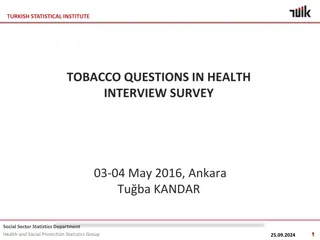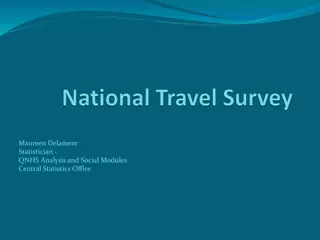Understanding Seasonality in Survey Design
Survey designers need to consider factors like seasonality and workload distribution when designing samples to ensure accurate results. This presentation discusses the impact of seasonal variations in income across different strata in a hypothetical survey country and how it affects the overall mean income calculation.
Download Presentation

Please find below an Image/Link to download the presentation.
The content on the website is provided AS IS for your information and personal use only. It may not be sold, licensed, or shared on other websites without obtaining consent from the author. Download presentation by click this link. If you encounter any issues during the download, it is possible that the publisher has removed the file from their server.
E N D
Presentation Transcript
Practical Considerations February 20, 2019 Noumea, NEW CALEDONIA
More than just the number Designing a sample involves more consideration than purely the expected precision of the results. In the real world, survey designers must consider additional issues in their designs. This presentation discusses two of the most common: Seasonality Interviewer workload Workload within teams Workload across teams
Hypothetical example Our survey country has three equally-sized strata: 1. Capital Island. Most people work in the construction and service industries. 2. Ag Island. Most people work in agriculture. The harvest for the main cash crop happens once a year. 3. Tourism Island. Most people work in tourism or making/selling handicrafts to cruise ship passengers, but the cruise season only lasts 6 months.
Capital Island Since most people do not have jobs that vary (systematically) with the season, net income is constant across the 12 months of the year. 1000 900 800 700 600 500 400 300 200 100 Mean income = $600 USD / month Jan Feb Mar Apr May Jun Jul Aug Sep Oct Nov Dec
Ag Island Since most people sell their cash crop at the same time, they have a very high income right after the harvest. harvest Mean income = $500 USD / month but is highly variable over the course of the year. 1000 900 800 700 600 500 400 300 200 100 Jan Feb Mar Apr May Jun Jul Aug Sep Oct Nov Dec
Tourism Island Most economic activity happens during the tourism season. peak of cruise season Mean income = $300 USD / month and varies across the year. 1000 900 800 700 600 500 400 300 200 100 Jan Feb Mar Apr May Jun Jul Aug Sep Oct Nov Dec
True mean Taking all three together, we know the true mean is (600 + 500 + 300)/3 = $467 USD / month 1000 900 800 700 600 500 400 300 200 100 Jan Feb Mar Apr May Jun Jul Aug Sep Oct Nov Dec
Scenario 1 Imagine that instead of having three teams each work separately on an island, we were going to send all three teams to work together on the same island, and then rotate the teams together. 1000 900 800 700 600 500 400 300 200 100 Mean income = (200 + 600 + 250)/3 = $350 USD / month Mean income = $600 USD / month Mean income = $250 USD / month Mean income = $200 USD / month Jan Feb Mar Apr May Jun Jul Aug Sep Oct Nov Dec
Scenario 2 Or to move together but start and end in the capital? Mean income = (750 + 600 + 350)/3 = $567 USD / month 1000 900 800 700 600 500 400 300 200 100 Mean income = $750 USD / month Mean income = $600 USD / month Mean income = $350 USD / month Jan Feb Mar Apr May Jun Jul Aug Sep Oct Nov Dec
Hypothetical example - summary As we can see, if income (or consumption or remittances, etc.) are impacted by seasonality, then we will introduce bias into our estimates if we do not take seasonality into consideration in the design. This is true also for surveys less than 12 months in length. If two rounds of the survey are conducted in different times of the year, changes in indicators (such as income) maybe be the result of seasonality rather than true changes. To address these issues, as much as possible, fieldwork should be spread across all geographies throughout the fieldwork.
Workload within teams Recall from the discussion of cluster effects the following table from Tanzania: # of Households/ Cluster 24 20 16 12 8 6 # of Clusters 193 218 252 298 328 364 Total # of Households 4,625 4,368 4,032 3,574 3,276 2,912 SE of Consumption (TSH) 725 688 650 612 594 578 In the end, 8 households per cluster was chosen because the vehicles owned by the NSO could fit 4 interviewers in addition to the supervisor and the driver.
Workload across teams We already discussed the importance of continuing the workload across the 12 month calendar to prevent negative impacts from seasonality. At the same time, we don t want large gaps in the workload of some teams if they are working in an area with a smaller sample size. During the sample design process, it can be useful to keep in mind the number of teams and how the workload will be distributed.
Workload across teams (2) Consider the workload below based solely on geography. The workload is very uneven and the Ag and Tourism teams will be idle much of the quarter increasing the risk of interviewer attrition. sample size 720 200 160 1080 # # clusters / quarter 18 5 4 clusters 72 20 16 108 Capital team Ag team Tourism team Total sample size 360 360 360 1080 # clusters / quarter 9 9 9 Now consider this alternative based on workload. # clusters 36 36 36 108 Team 1 (Capital) Team 2 (Capital) Team 3 (Ag + Tourism) Total























